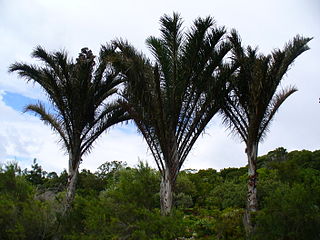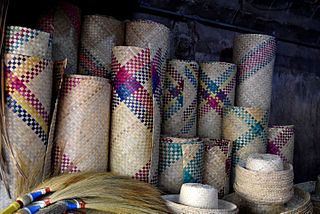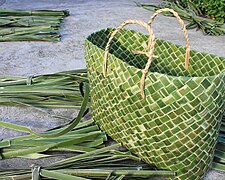
Abacá, binomial name Musa textilis, is a species of banana native to the Philippines, grown as a commercial crop in the Philippines, Ecuador, and Costa Rica. The plant, also known as Manila hemp, has great economic importance, being harvested for its fiber, also called Manila hemp, extracted from the leaf-stems. Abacá is also the traditional source of lustrous fiber hand-loomed into various indigenous textiles in the Philippines like t'nalak, as well as colonial-era sheer luxury fabrics known as nipis. They are also the source of fibers for sinamay, a loosely woven stiff material used for textiles as well as in traditional Philippine millinery.

A basket is a container that is traditionally constructed from stiff fibers and can be made from a range of materials, including wood splints, runners, and cane. While most baskets are made from plant materials, other materials such as horsehair, baleen, or metal wire can be used. Baskets are generally woven by hand. Some baskets are fitted with a lid, while others are left open on top.

Raffia palms (Raphia) are a genus of about twenty species of palms native to tropical regions of Africa, and especially Madagascar, with one species also occurring in Central and South America. R. taedigera is the source of raffia fibers, which are the veins of the leaves, and this species produces a fruit called "brazilia pods", "uxi nuts" or "uxi pods".

Pandanus is a genus of monocots with some 750 accepted species. They are palm-like, dioecious trees and shrubs native to the Old World tropics and subtropics. The greatest number of species are found in Madagascar and Malesia. Common names include pandan, screw palm, and screw pine. They are classified in the order Pandanales, family Pandanaceae.

Corypha is a genus of palms, native to India, Malaysia, Indonesia, the Philippines, New Guinea and northeastern Australia. They are fan palms, and the leaves have a long petiole terminating in a rounded fan of numerous leaflets.

Pandanus tectorius is a species of Pandanus (screwpine) that is native to Malesia, eastern Australia, and the Pacific Islands. It grows in the coastal lowlands typically near the edge of the ocean. Common names in English include thatch screwpine, Tahitian screwpine, hala tree, pandanus, and pu hala in Hawaiian. The fruit is sometimes known as hala fruit.

Borassus is a genus of five species of fan palms, native to tropical regions of Africa, Asia and New Guinea.

Arenga pinnata is an economically important feather palm native to tropical Asia, from eastern India east to Malaysia, Indonesia, and the Philippines in the east. Common names include sugar palm, areng palm, black sugar palm, and kaong palm, among other names.

Pandanus utilis, the common screwpine is, despite its name, a monocot and not a pine. It is native to Madagascar and naturalised in Mauritius and the Seychelles.
Lauhala, lau meaning "leaf" in the Hawaiian language, refers to the leaves of the hala tree (Pandanus tectorius).

A baníg is a handwoven mat usually used in East Asia and the Philippines for sleeping and sitting. This type of mat is traditionally made in the Philippines.

Borassus flabellifer, commonly known as doub palm, palmyra palm, tala palm, toddy palm, wine palm or ice apple is native to the Indian subcontinent and Southeast Asia. It is reportedly naturalized in Socotra and parts of China.

Saba banana, is a triploid hybrid (ABB) banana cultivar originating from the Philippines. It is primarily a cooking banana, though it can also be eaten raw. It is one of the most important banana varieties in Philippine cuisine. It is also sometimes known as the "cardaba banana", though the latter name is more correctly applied to the cardava, a very similar cultivar also classified within the saba subgroup.

Pandanus furcatus Roxb., also known as korr, pandan or Himalayan/Nepal screw pine, is native to the Sikkim Himalaya of Northeast India, Bhutan and Nepal, Malaysia, Indonesia, Australia and West Africa, and occurs on moist and shady slopes of ravines between 300 and 1500 m. As might be expected it is cold-resistant and able to tolerate occasional light frost, slowly growing to a tall branched tree - about 17 m at maturity - and perched on stilt-like aerial roots. The crown is made up of 5 m long, pale-green leaves, with finely toothed margins, while its fruits are sweet-tasting and edible. The leathery flower spathes are golden-yellow, the lowermost are largest and about 1m in length. These give rise to cone-like fruits, 15–25 cm long, that are bright orange to red when mature and consist of 5-6 angled drupes.

Astrocaryum standleyanum is a species of palm known by many common names, including chumba wumba, black palm, chonta, chontadura, coquillo, palma negra, pejibaye de montaña, güerre, güérregue, güinul, mocora, pucaishchi (Chachi), and chunga (Emberá). It is native to Central and South America, where its distribution extends from Nicaragua to Ecuador. It is most common in central Panama, even becoming "abundant" in the tropical forests around the Panama Canal, but in general it is not a common plant.

Raphia farinifera is a tropical African palm tree occurring in lowland riparian and swamp forest, also around human habitations and cultivated locations, on stream banks and other moist situations at altitudes of 50–1000 m. Found in Angola, Benin, Burkina, Cameroon, Gambia, Ghana, Guinea, Ivory Coast, Kenya, Madagascar, Malawi, Mauritius, Mozambique, Nigeria, Réunion, Senegal, Seychelles, Sierra Leone, Tanzania, Togo, Uganda, Zambia and Zimbabwe, and naturalised in Madagascar. Its genus is derived from 'raphis' = needle, probably in reference to the 4 mm long yellowish spines on the margins and main veins of the leaflets. The specific name refers to a type of starchy flour obtained from the trunk pith – 'farina' = starch, 'fera' = bearing.

Pandanus dubius, commonly known as bakong or knob-fruited screwpine, is a species of Pandanus (screwpine) native to Island Southeast Asia, New Guinea, and the Western Pacific islands, and possibly also to the Andaman and Nicobar Islands.
Pandanus whitmeeanus, commonly known as the Samoan pandanus, is a species of Pandanus (screwpine) believed to be native to Vanuatu. It has been introduced to Samoa, Tonga, the Cook Islands, and the Hoorn Islands by Austronesian voyagers. It is also known in Samoan and Tongan as ‘ara ‘āmoa or paogo.
Pandanus spicatus a species of plant in the family Pandanaceae. It is native to Madagascar. It is known from only one locatlity, Amber Mountain National Park and the associated Montagne d'Ambre forest, in northern Madagascar. Pandanus spicatus is a small tree first collected in 1961 in dense moist forests of northern Madagascar. It grows to 8 m tall, with a 15 cm diameter trunk and no prop roots. Several suberect branches grow from the top of the tree. These are 15 cm in diameter with broad conic spines and covered with persistent leaf bases. Leaves are thick and leathery, up to 3 m long and 15-16.5 cm wide. Fruiting structures are terminal, stand erect and have up to 9 complex fruits (syncarps), concealed in erect or ascending leaves. Fruits are egg-shaped,9 cm long and 7 cm in diameter.
Pandanus concretus is a dioecious tree in the screwpine genus. It is endemic to Madagascar, found in Toliara province. Pandanus concretus is the accepted name, but it has also been called Pandanus centrifugalis, P. dauphinensis, P. erectus and P. madagascarensis.






















